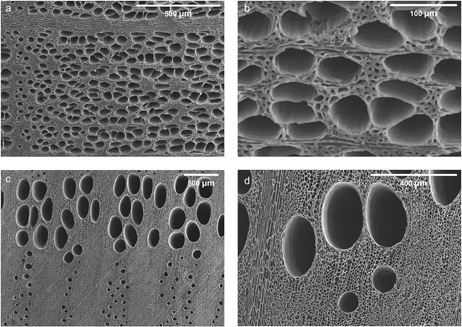Crossref Citations
This article has been cited by the following publications. This list is generated based on data provided by
Crossref.
Kardashev, B. K.
Orlova, T. S.
Smirnov, B. I.
Gutierrez, A.
and
Ramirez-Rico, J.
2013.
Structure-mediated transition in the behavior of elastic and inelastic properties of beach tree bio-carbon.
Physics of the Solid State,
Vol. 55,
Issue. 9,
p.
1884.
Johnson, M.T.
Childers, A.S.
Ramírez-Rico, J.
Wang, H.
and
Faber, K.T.
2013.
Thermal conductivity of wood-derived graphite and copper–graphite composites produced via electrodeposition.
Composites Part A: Applied Science and Manufacturing,
Vol. 53,
Issue. ,
p.
182.
Johnson, M.T.
Childers, A.S.
De Carlo, F.
Xiao, X.
and
Faber, K.T.
2013.
Wood-derived copper–graphite composites produced via additive-assisted electrodeposition.
Composites Science and Technology,
Vol. 89,
Issue. ,
p.
61.
Liu, Yuanchao
Liu, Qinglei
Gu, Jiajun
Kang, Danmiao
Zhou, Fengyu
Zhang, Wang
Wu, Yu
and
Zhang, Di
2013.
Highly porous graphitic materials prepared by catalytic graphitization.
Carbon,
Vol. 64,
Issue. ,
p.
132.
Gutiérrez-Pardo, A.
Ramírez-Rico, J.
de Arellano-López, A. R.
and
Martínez-Fernández, J.
2014.
Characterization of porous graphitic monoliths from pyrolyzed wood.
Journal of Materials Science,
Vol. 49,
Issue. 22,
p.
7688.
Shpeizman, V. V.
Orlova, T. S.
Kardashev, B. K.
Smirnov, B. I.
Gutierrez-Pardo, A.
and
Ramirez-Rico, J.
2014.
Effect of carbonization temperature on the microplasticity of wood-derived biocarbon.
Physics of the Solid State,
Vol. 56,
Issue. 3,
p.
538.
Xie, Xinfeng
and
Goodell, Barry
2014.
Deterioration and Protection of Sustainable Biomaterials.
Vol. 1158,
Issue. ,
p.
147.
Orlova, T. S.
Kardashev, B. K.
Smirnov, B. I.
Gutierrez-Pardo, A.
Ramirez-Rico, J.
and
Martinez-Fernandez, J.
2015.
Microstructure, elastic and inelastic properties of partially graphitized biomorphic carbons.
Physics of the Solid State,
Vol. 57,
Issue. 3,
p.
586.
Mitchell, Shelby Taylor
Frese, Natalie
Gölzhäuser, Armin
Bowers, Amanda
and
Sattler, Klaus
2015.
Ultralight carbon nanofoam from naphtalene-mediated hydrothermal sucrose carbonization.
Carbon,
Vol. 95,
Issue. ,
p.
434.
Popov, V. V.
Orlova, T. S.
Gutierrez-Pardo, A.
and
Ramirez-Rico, J.
2015.
Specific features of the electrical properties in partially graphitized porous biocarbons of beech wood.
Physics of the Solid State,
Vol. 57,
Issue. 9,
p.
1746.
Gutiérrez-Pardo, A.
Ramírez-Rico, J.
Cabezas-Rodríguez, R.
and
Martínez-Fernández, J.
2015.
Effect of catalytic graphitization on the electrochemical behavior of wood derived carbons for use in supercapacitors.
Journal of Power Sources,
Vol. 278,
Issue. ,
p.
18.
Ramirez-Rico, J.
Gutierrez-Pardo, A.
Martinez-Fernandez, J.
Popov, V.V.
and
Orlova, T.S.
2016.
Thermal conductivity of Fe graphitized wood derived carbon.
Materials & Design,
Vol. 99,
Issue. ,
p.
528.
Orlova, T. S.
Kardashev, B. K.
Smirnov, B. I.
Gutierrez-Pardo, A.
and
Ramirez-Rico, J.
2016.
Microstructure, elastic, and inelastic properties of biomorphic carbons carbonized using a Fe-containing catalyst.
Physics of the Solid State,
Vol. 58,
Issue. 12,
p.
2481.
Orlova, T. S.
Parfen’eva, L. S.
Smirnov, B. I.
Gutierrez-Pardo, A.
and
Ramirez-Rico, J.
2016.
Thermal conductivity of partially graphitized biocarbon obtained by carbonization of medium-density fiberboard in the presence of a Ni-based catalyst.
Physics of the Solid State,
Vol. 58,
Issue. 1,
p.
208.
Shpeizman, V. V.
Orlova, T. S.
Smirnov, B. I.
Gutierrez-Pardo, A.
and
Ramirez-Rico, J.
2016.
Strength and microplasticity of biocarbons prepared by carbonization in the presence of a catalyst.
Physics of the Solid State,
Vol. 58,
Issue. 4,
p.
703.
Childers, A.S.
Brodnik, N.R.
and
Faber, K.T.
2016.
Interfacial frictional stresses and fracture toughness of biomorphic graphite/copper interfaces.
Materials Letters,
Vol. 174,
Issue. ,
p.
106.
Popov, V. V.
Orlova, T. S.
Gutierrez-Pardo, A.
and
Ramirez-Rico, J.
2017.
Features of electrical properties of BE-C(Fe) biocarbons carbonized in the presence of an Fe-containing catalyst.
Physics of the Solid State,
Vol. 59,
Issue. 4,
p.
703.
Schnucklake, Maike
Kuecken, Sophie
Fetyan, Abdulmonem
Schmidt, Johannes
Thomas, Arne
and
Roth, Christina
2017.
Salt-templated porous carbon–carbon composite electrodes for application in vanadium redox flow batteries.
Journal of Materials Chemistry A,
Vol. 5,
Issue. 48,
p.
25193.
Johnson, M. T.
Keck, C. H. C.
and
Faber, K. T.
2017.
Experimental Model Validation of High Aspect Ratio Through-Hole Filling by Additive-Assisted Copper Electrodeposition.
Journal of The Electrochemical Society,
Vol. 164,
Issue. 2,
p.
D48.
Gomez‐Martin, Aurora
Martinez‐Fernandez, Julian
Ruttert, Mirco
Heckmann, Andreas
Winter, Martin
Placke, Tobias
and
Ramirez‐Rico, Joaquin
2018.
Iron‐Catalyzed Graphitic Carbon Materials from Biomass Resources as Anodes for Lithium‐Ion Batteries.
ChemSusChem,
Vol. 11,
Issue. 16,
p.
2776.





